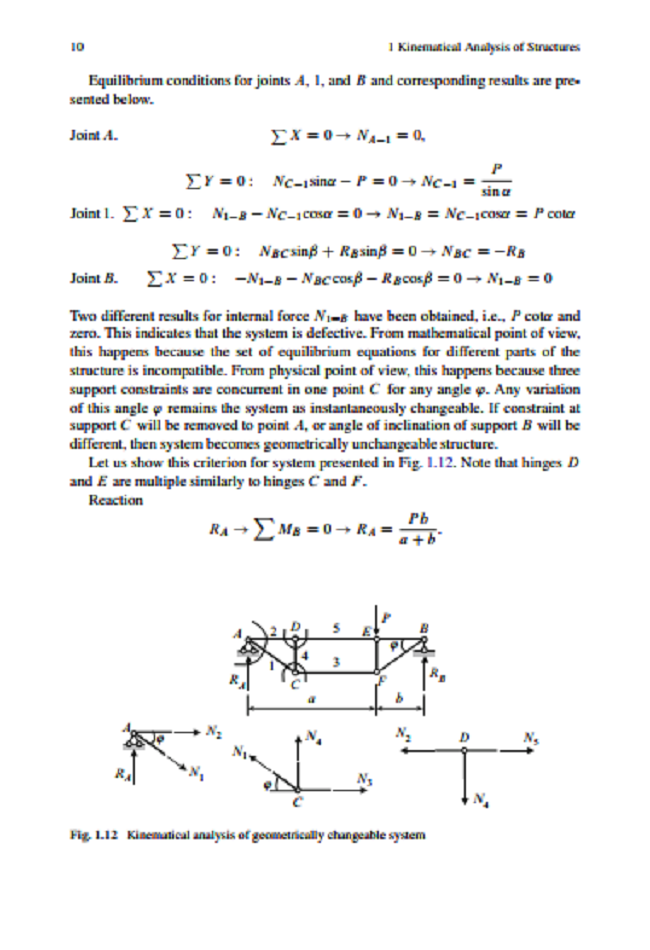Advanced methods of structural analysis book
Theory
of the engineering structures is a fundamental science. Statements and
methods of this science are widely used in different fields of
engineering. Among them
are the civil engineering, ship-building, aircraft, robotics, space structures, as well
as numerous structures of special types and purposes – bridges, towers, etc. In recent
years , even micromechanical devices become objects of structural analysis
are the civil engineering, ship-building, aircraft, robotics, space structures, as well
as numerous structures of special types and purposes – bridges, towers, etc. In recent
years , even micromechanical devices become objects of structural analysis
This book contains introduction, three parts (14 chapters), and appendixIntroduction provides the subject and purposes of Structural Analysis, principal
concepts, assumptions, and fundamental approaches.Part 1 (Chaps. 1–6) is devoted to analysis of statically determinate structures.
Among them are multispan beams, arches, trusses, cables, and frames. Construction of influence lines and their application are discussed with great details. Also
this part contains analytical methods of computation of displacement of deformable
structures, subjected to different actions. Among them are variety loads, change of
temperature, and settlements of supports.Part 2 (Chaps. 7–11) is focused on analysis of statically indeterminate structures
using the fundamental methods. Among them are the force and displacement methods (both methods are presented in canonical form), as well as the mixed method.
Also the influence line method (on the basis of force and displacement methods) is
presented. Analysis of continuous beams, arches, trusses, and frames is considered
in detail.
Chapter 11 is devoted to matrix stiffness method which is realized in the modern engineering software. Usually, the physical meaning of all matrix procedures
presents serious difficulties for students. Comparison of numerical procedures obtained by canonical equations and their matrix presentations, which are applied to
the same structure, allows trace and understands meaning of each stage of matrix
analysis. This method is applied for fixed loads, settlement of supports, temperature
changes, and construction of influence lines.Part 3 (Chaps. 12–14) contains three important topics of structural analysis. They
are plastic behavior of structures, stability of elastic structures with finite and infinite
number of degrees of freedom, including analysis of structures on the basis of the
deformable design diagram (P – analysis), and the free vibration analysis.
Each chapter contains problems for self-study. Answers are presented to all
problems
concepts, assumptions, and fundamental approaches.Part 1 (Chaps. 1–6) is devoted to analysis of statically determinate structures.
Among them are multispan beams, arches, trusses, cables, and frames. Construction of influence lines and their application are discussed with great details. Also
this part contains analytical methods of computation of displacement of deformable
structures, subjected to different actions. Among them are variety loads, change of
temperature, and settlements of supports.Part 2 (Chaps. 7–11) is focused on analysis of statically indeterminate structures
using the fundamental methods. Among them are the force and displacement methods (both methods are presented in canonical form), as well as the mixed method.
Also the influence line method (on the basis of force and displacement methods) is
presented. Analysis of continuous beams, arches, trusses, and frames is considered
in detail.
Chapter 11 is devoted to matrix stiffness method which is realized in the modern engineering software. Usually, the physical meaning of all matrix procedures
presents serious difficulties for students. Comparison of numerical procedures obtained by canonical equations and their matrix presentations, which are applied to
the same structure, allows trace and understands meaning of each stage of matrix
analysis. This method is applied for fixed loads, settlement of supports, temperature
changes, and construction of influence lines.Part 3 (Chaps. 12–14) contains three important topics of structural analysis. They
are plastic behavior of structures, stability of elastic structures with finite and infinite
number of degrees of freedom, including analysis of structures on the basis of the
deformable design diagram (P – analysis), and the free vibration analysis.
Each chapter contains problems for self-study. Answers are presented to all
problems


